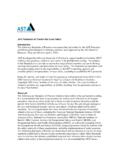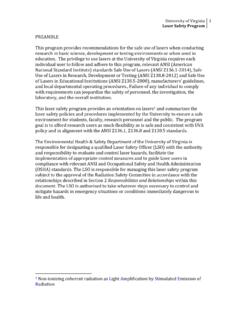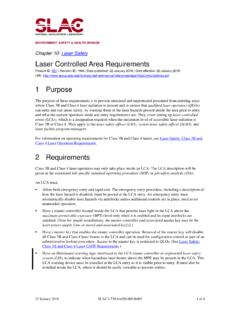Transcription of Laser+ C (C60A) Product Information - DAK Americas
1 Laser+ C (C60A) Product Information polyethylene terephthalate resin DAK Americas LLC Gateway Corporate Center, Suite 210 223 Wilmington W Chester Pike Chadds Ford, PA 19317 1-888-738-2002 fax: 610-558-7385 PDS-C60A 150303KH ISO 9001 10004457 FSSC 22000 PAS 223 10004457 General Laser+ C (C60A) is a unique copolymer particularly suited for use in the custom PET container applications where clarity and neutral color are desired. It is a medium intrinsic viscosity (IV) Product that gives the end user a strong clear bottle and offers excellent processing and consistency. Product Description Bi-orientation of Laser+ C (C60A) by injection/stretch blow molding provides optimal barrier and mechanical properties, including excellent vacuum performance.
2 It performs well in both single- and two-stage processes used in the manufacturing of PET containers. Laser+ C (C60A) offers excellent clarity and color, while maintaining good reheat characteristics for stretch blow molding. In addition, because it is a copolymer resin, it offers reduced crystallization rates and a wide processing window. Sales Specification PropertyValueTest MethodIntrinsic L* CIE84 minColor b* ppm maxDAK-QAR-SOP-0010 DAK-QAR-SOP-0011 Certification Laser+ C (C60A) is ideally suited for food packaging applications and is considered in compliance with the Food and Drug Administration (FDA) Food Contact Notification (FCN) 000635, and Health Canada Health Products and Food Branch (HPFB) file KS 05103104 for PET polymers.
3 Typical Properties PropertyValueTest MethodMos iture m axDAK-QAR-SOP-0013 Fines1, +24 Mes m axDAK-QAR-SOP-0014 Pellet Size, nom inal53 5 chips /gDAK-QAR-SOP-0015 Crys tallinity>45%DAK-QAR-SOP-0016 Flat Cylinder Shape3x3x2 m mDAK-QAR-SOP-0017 Melt Point, nom inal246 CDAK-QAR-SOP-0016 Bulk Dens lb / ft3 DAK-QAR-SOP-00181 As packaged These values represent the anticipated performance data for these polyester resins and intermediates; they are not intended to be used as design data. We believe this Information is the best currently available on the subject. It is offered as a possible helpful suggestion in the experimentation you may care to undertake along these lines.
4 It is subject to revision as additional knowledge and experience is gained. DAK makes no guarantee of results and assumes no obligation or liability whatsoever in connection with this Information . This publication is not a license to operate under, or intended to suggest infringement of, any existing patents. CAUTION: Do not use in medical applications involving permanent implantation in the human body. For other medical applications, see DAK Medical Caution Statement . Laser+ C (C60A) Product Information polyethylene terephthalate resin DAK Americas LLC Gateway Corporate Center, Suite 210 223 Wilmington W Chester Pike Chadds Ford, PA 19317 1-888-738-2002 fax: 610-558-7385 PDS-C60A 150303KH ISO 9001 10004457 FSSC 22000 PAS 223 10004457 Material Drying Proper drying of polyethylene terephthalate (PET) is essential to produce a high quality part (container, film, etc.)
5 With optimum physical properties. PET is hygroscopic, meaning that when it is exposed to humid atmospheres, it will absorb moisture. In PET the moisture is not only on the surface but diffuses slowly through the whole pellet and is firmly held by molecular attraction. Before processing the PET, this moisture must be removed. Carefully controlled drying of all PET is an essential requirement for optimum processing performance and final Product properties. If drying is not carried out properly, to the known requirements of the type of PET in use, then deficiencies in process and Product will results. The deficiencies will be impossible to remedy by later process changes.
6 These defects arise in the injection molding or extrusion processes because at PET melt temperature (250 -280 C) any water present causes hydrolytic degradation of the PET, almost instantaneously, with the resultant loss in intrinsic viscosity (IV). Significant drops in IV cause loss of process control and reductions in end Product properties. Drying of PET polymer involves the diffusion of absorbed moisture from the interior of the polymer chip to its surroundings and, subsequently the removal of moisture from the bulk of polymer chips. Moisture removal can be achieved by heating the polymer chip under dry air or vacuum.
7 In an air drying system, heated dehumidified air flows up through a chip bed and returns to the dehumidifier. The key requirements for a reliable drying process are: Drying temperature: The ACTUAL chip temperature should achieve between 300 and 340 F measured at the dryer exit. Dehumidified air temperature: Correctly designed equipment should operate at temperatures up to 340 F measured on entry to the dryer hopper, with an absolute maximum of 370 F to prevent possible discoloration. Dehumidified air dew point: This should not be allowed to rise above 34 F and should preferably be 40 F or lower, measure after the desiccant bed.
8 Always check the correct regeneration temperatures are being used. Dehumidified air flow through the chip bed: Most dryers operate at around l cfm of airflow per 1lb/hr of PET chip as a minimum requirement, with the airflow at the correct temperature and dew point. Chip residence time (drying time): DAK recommends a chip residence time for Laser+ PET of not less than four hours and preferably six hours. This is the theoretical drying time, which is calculated by dividing dryer capacity in lbs. by throughput in Extended periods of high temperature can adversely affect the polymer processing conditions. In the event of a stoppage for an extended period, dry polymer can be stored in the dryer-hopper by reducing the air temperature to 240 F (or even lower).
9











